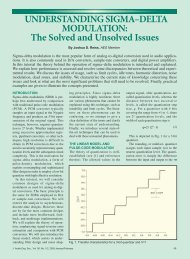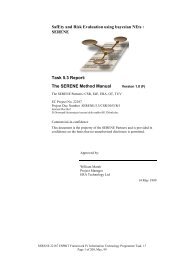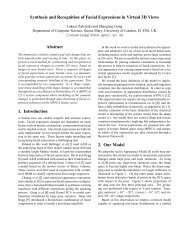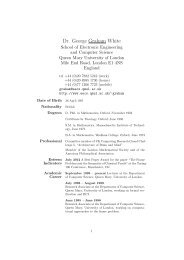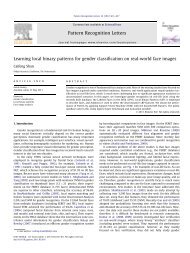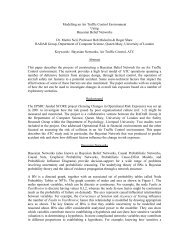DEAP: A Database for Emotion Analysis using Physiological Signals
DEAP: A Database for Emotion Analysis using Physiological Signals
DEAP: A Database for Emotion Analysis using Physiological Signals
Create successful ePaper yourself
Turn your PDF publications into a flip-book with our unique Google optimized e-Paper software.
IEEE TRANS. AFFECTIVE COMPUTING 13<br />
TABLE 8<br />
F1-scores <strong>for</strong> fusion of the best two modalities and all three modalities <strong>using</strong> the equal weights and optimal weights<br />
scheme. For comparison, the F1-score <strong>for</strong> the best single modality is also given.<br />
Arousal Valence Liking<br />
Modality Optimal w. Equal w. Modality Optimal w. Equal w. Modality Optimal w. Equal w.<br />
Best single modality MCA 0.618 —– PER 0.608 —– MCA 0.634 —–<br />
Best two modalities EEG,MCA 0.631 0.629 MCA,PER 0.638 0.652 MCA,PER 0.622 0.642<br />
All three modalities All 0.616 0.618 All 0.647 0.640 All 0.618 0.607<br />
only the two best-per<strong>for</strong>ming modalities were considered.<br />
Though fusion generally outper<strong>for</strong>ms the single<br />
modalities, it is only significant <strong>for</strong> the case of MCA,PER<br />
weighted equally in the valence scale (p = 0.025).<br />
While the presented results are significantly higher<br />
than random classification, there remains much room<br />
<strong>for</strong> improvement. Signal noise, individual physiological<br />
differences and limited quality of self-assessments make<br />
single-trial classification challenging.<br />
7 CONCLUSION<br />
In this work, we have presented a database <strong>for</strong> the<br />
analysis of spontaneous emotions. The database contains<br />
physiological signals of 32 participants (and frontal<br />
face video of 22 participants), where each participant<br />
watched and rated their emotional response to 40 music<br />
videos along the scales of arousal, valence, and<br />
dominance, as well as their liking of and familiarity<br />
with the videos. We presented a novel semi-automatic<br />
stimuli selection method <strong>using</strong> affective tags, which was<br />
validated by an analysis of the ratings participants gave<br />
during the experiment. Significant correlates were found<br />
between the participant ratings and EEG frequencies.<br />
Single-trial classification was per<strong>for</strong>med <strong>for</strong> the scales of<br />
arousal, valence and liking <strong>using</strong> features extracted from<br />
the EEG, peripheral and MCA modalities. The results<br />
were shown to be significantly better than random classification.<br />
Finally, decision fusion of these results yielded<br />
a modest increase in the per<strong>for</strong>mance, indicating at least<br />
some complementarity to the modalities.<br />
The database is made publicly available and it is our<br />
hope that other researchers will try their methods and<br />
algorithms on this highly challenging database.<br />
ACKNOWLEDGMENTS<br />
The researchleading to these results has been per<strong>for</strong>med<br />
in the frameworks of European Community’s Seventh<br />
FrameworkProgram(FP7/2007-2011)undergrantagreement<br />
no. 216444 (PetaMedia). Furthermore, the authors<br />
gratefully acknowledge the support of the BrainGain<br />
Smart Mix Programme of the Netherlands Ministry of<br />
Economic Affairs, the Netherlands Ministry of Education,<br />
Culture and Science and the Swiss National Foundation<br />
<strong>for</strong> Scientific Research and the NCCR Interactive<br />
Multimodal In<strong>for</strong>mation Management (IM2). The authors<br />
also thank Sebastian Schmiedeke and Pascal Kelm<br />
at the Technische Universität Berlin <strong>for</strong> per<strong>for</strong>ming the<br />
shot boundary detection on this dataset.<br />
REFERENCES<br />
[1] M. K. Shan,F. F. Kuo, M. F. Chiang, andS. Y. Lee,“<strong>Emotion</strong>-based<br />
music recommendation by affinity discovery from film music,”<br />
Expert Syst. Appl., vol. 36, no. 4, pp. 7666–7674, September 2009.<br />
[2] M.Tkalčič,U.Burnik,andA.Koˇsir,“Usingaffectiveparametersin<br />
a content-based recommender system <strong>for</strong> images,” User Modeling<br />
and User-Adapted Interaction, pp. 1–33–33, September 2010.<br />
[3] J. J. M. Kierkels, M. Soleymani, and T. Pun, “Queries and tags in<br />
affect-based multimedia retrieval,” in Proc. Int. Conf. Multimedia<br />
and Expo. New York, NY, USA: IEEE Press, 2009, pp. 1436–1439.<br />
[4] M. Soleymani, J. Lichtenauer, T. Pun, and M. Pantic, “A multimodal<br />
Affective<strong>Database</strong><strong>for</strong> AffectRecognition andImplicit Tagging,”<br />
IEEE Trans. Affective Computing, Special Issue on Naturalistic<br />
Affect Resources <strong>for</strong> System Building and Evaluation, under review.<br />
[5] A. Savran, K. Ciftci, G. Chanel, J. C. Mota, L. H. Viet, B. Sankur,<br />
L.Akarun,A.Caplier,andM.Rombaut,“<strong>Emotion</strong>detectioninthe<br />
loop from brain signals and facial images,” in Proc. eNTERFACE<br />
2006 Workshop, Dubrovnik, Croatia, Jul. 2006.<br />
[6] P. Ekman, W. V. Friesen, M. O’Sullivan, A. Chan, I. Diacoyanni-<br />
Tarlatzis, K. Heider, R. Krause, W. A. LeCompte, T. Pitcairn,<br />
and P. E. Ricci-Bitti, “Universals and cultural differences in the<br />
judgments of facial expressions of emotion.” Journal of Personality<br />
and Social Psychology, vol. 53, no. 4, pp. 712–717, Oct. 1987.<br />
[7] W. G. Parrott, <strong>Emotion</strong>s in Social Psychology: Essential Readings.<br />
Philadelphia: Psychology Press, 2001.<br />
[8] R. Plutchik, “The nature of emotions,” American Scientist, vol. 89,<br />
p. 344, 2001.<br />
[9] J. A. Russell, “A circumplex model of affect,” Journal of Personality<br />
and Social Psychology, vol. 39, no. 6, pp. 1161–1178, 1980.<br />
[10] M. M. Bradley and P. J. Lang, “Measuring emotion: the selfassessment<br />
manikin and the semantic differential.” J. Behav. Ther.<br />
Exp. Psychiatry, vol. 25, no. 1, pp. 49–59, Mar. 1994.<br />
[11] M. Pantic, M. Valstar, R. Rademaker, and L. Maat, “Web-based<br />
database <strong>for</strong> facial expression analysis,” in Proc. Int. Conf. Multimedia<br />
and Expo, Amsterdam, The Netherlands, 2005, pp. 317–321.<br />
[12] E. Douglas-Cowie, R. Cowie, and M. Schröder, “A new emotion<br />
database: Considerations, sources and scope,” in Proc. ISCA Workshop<br />
on Speech and <strong>Emotion</strong>, 2000, pp. 39–44.<br />
[13] H. Gunes and M. Piccardi, “A bimodal face and body gesture<br />
database <strong>for</strong> automatic analysis of human nonverbal affective<br />
behavior,” in Proc. Int. Conf. Pattern Recognition, vol. 1, 2006, pp.<br />
1148–1153.<br />
[14] G. Fanelli, J. Gall, H. Romsdorfer, T. Weise, and L. Van Gool, “A<br />
3-D audio-visual corpus of affective communication,” IEEE Trans.<br />
Multimedia, vol. 12, no. 6, pp. 591–598, Oct. 2010.<br />
[15] M. Grimm, K. Kroschel, and S. Narayanan, “The vera am mittag<br />
german audio-visual emotional speech database,” in Proc. Int.<br />
Conf. Multimedia and Expo, 2008, pp. 865 –868.<br />
[16] J. A. Healey, “Wearable and automotive systems <strong>for</strong> affect recognition<br />
from physiology,” Ph.D. dissertation, MIT, 2000.




